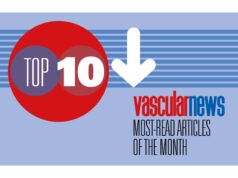
The use of GPS mapping tools has become a cornerstone of modern life. A study published by the Journal of Vascular Surgery has demonstrated the clinical opportunities offered by this revolutionary technology, potentially allowing vascular surgeons to accurately measure the walking capacity of their peripheral artery disease patients.
Prasad Jetty, Husain Khambati (Ottawa Hospital and the University of Ottawa, Ottawa, Canada) and colleagues explain that the use of a treadmill is the current gold standard for measuring patient walking capacity “due to its strong reproducibility and reliability”. However, they argue, “Treadmill testing is not always reflective of the patient’s natural walking conditions, and it may not be fully accessible in every vascular clinic.” Indeed, a survey conducted by Jetty et al during the 2015 Canadian Society for Vascular Surgery annual meeting indicated that 93% of the vascular surgeons asked did not rely on treadmill testing as part of their diagnostic algorithm.
While the Walking Impairment Questionnaire (WIQ) was developed as an alternative to treadmill tests, its subjective nature means that there is a wide discrepancy between estimated and actual walking distances.
In this study, Jetty and colleagues were investigating the suitability of Google’s readily-available GPS-based mapping tool for walking distance measurement in vascular claudication patients. This approach, they write, “is aimed at combining the reproducibility and accuracy of treadmill testing with the real-world data capture of the WIQ.”
Patients presenting to the outpatient vascular surgery clinic between November 2013 and April 2014 at the Ottawa Hospital with vasculogenic calf, buttock, and thigh claudication symptoms were identified and prospectively enrolled in this study. Onset of claudication symptoms and maximum walking distance were evaluated using four tools: clinical history; WIQ; Google Maps distance calculator (patients were asked to report their daily walking routes on the Google Maps-based tool runningmap.com, and walking distances were calculated accordingly); and treadmill testing for onset of symptoms and maximum walking distance, recorded in a double-blinded fashion.
Fifteen patients were recruited for the study. Determination of walking distances using Google Maps “proved to be more accurate than by both clinical history and WIQ, correlating highly with the gold standard of treadmill testing for both claudication onset (r=0.805; p<0.001) and maximum walking distance (r=0.928; p<0.0001),” Jetty and colleagues report. In addition, distances were generally under-reported on history and WIQ. The Google Maps tool was also efficient, with reporting times averaging below four minutes.
“From a pragmatic standpoint, Google Maps is easy to use, with every internet computer of device having access to the service,” Jetty explains. “Although not statistically significant, there was a trend towards shorter reporting times in comparison to the WIQ, with overall reporting times averaging four minutes. IT also does not require the additional personnel, space, and equipment necessary to obtain a treadmill test assessment, and its widespread availability may make it useful in other specialities that assess a patient’s walking abilities, such as orthopaedics and physiatry.”
“For vascular claudicants with no other walking limitations, Google Maps is a promising new tool that combines the objective strengths of the treadmill test and incorporates real-world walking environments,” Jetty told Vascular News. “It offers an accurate, efficient, inexpensive, and readily accessible way to assess walking distances in patients with peripheral vascular disease.”













